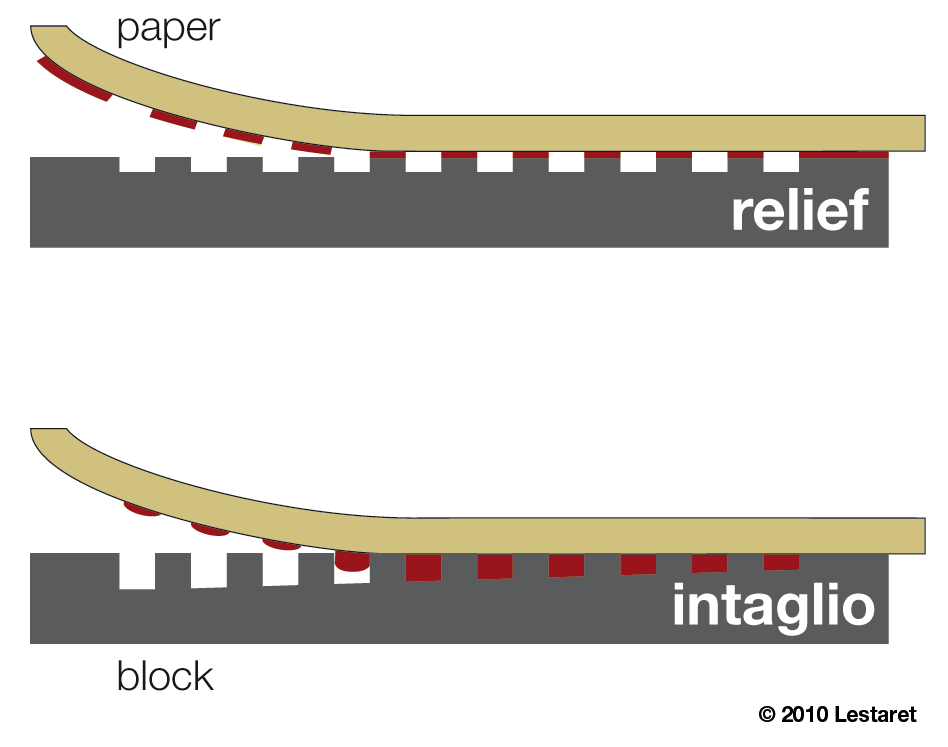

Printmaking is an art of transfering printed images on a surface. A print is a hand produced printer that has been transferred from a printing surface to a paper. It does not simply mean photographic reproductions but rather it encompasses reproduction or multiples made directly from the same block
Printmaking is a sometimes misunderstood aspect of visual art. The distinction between fine art prints and "limited edition prints" which are actually commercially reproduced prints (posters which have been signed) is not always easy to make.
Relief Printing
this is printing from a raised surface. A simple example of relief printing is a rubber stamp pressed into a stamp pad and pressed onto a piece of paper. Relief printing plates are made from flat sheets of material such as wood, linoleum, metal, styrofoam etc. After drawing a picture on the surface, the artist uses tools to cut away the areas that will not print. A roller - called a brayer - is used to spread ink on the plate. A sheet of paper is placed on top of the plate and the image is transferred by rubbing with the hand or a block of wood, or by being run through a printing press. The completed print is a mirror image of the original plate.
Woodcut - Historical uses: Textiles and other decorative purposes, playing cards, calendars and book illustrations.
Woodcut - Artists worth studying: Holbein the Younger, Fred Hagen, Vincent Van Gogh, James Whistler, any Japanese printmaker




Intaglio
This describes prints that are made by cutting the picture into the surface of the printing plate. Using a sharp V-shaped tool - called a burin - the printmaker gouges the lines of an image into the surface of a smooth polished sheet of metal or in some cases a piece of plexiglass. To make a print, ink is pushed into the lines of the design. The surface is then wiped clean so that the only areas with ink are the lines. A sheet of paper which has been soaked in water is then placed on the plate which is run through a printing press. The paper is literally forced into the small lines that have been cut into the plate. A variation of this technique is known as etching. With etching, acids are used to eat into the metal plate.
Artists worth studying: Francisco Goya, Pablo Picasso, Thomas Gainsborough, Rembrandt van Ryn, Albrecht Durer




Planography (Lithography)
relief prints are created from a raised surface, and intaglio prints are created from a cut surface. Planography however, is the printing of a flat surface. Lithography is the art of printing from a flat stone (limestone) or metal plate by a method based on the simple fact that grease attracts grease as it repels water. A design or image is drawn on the surface with a greasy material - grease crayon, pencil or ink - and then water and printing ink are applied. The greasy parts absorb the ink and the wet parts do not. Acids are often used with this type of printmaking to etch the stone and prevent grease from traveling where it should not. For example, if a finger is placed on the surface, enough grease is transferred and as such, the fingerprint will attract the ink. Unfortunately, lithography is a printing process which requires the use of proper facilities and materials. However, showing your students examples of lithography will help them to appreciate the fine art of printmaking even more.
History and uses: Lithography was invented in 1798. Its main advantage is the great number of prints that can be pulled.
Artists worth studying: Eugene Delacroix, Edouard Manet, Henri de Toulouse-Lautrec, Edvard Munch


History and uses: Lithography was invented in 1798. Its main advantage is the great number of prints that can be pulled.
Artists worth studying: Eugene Delacroix, Edouard Manet, Henri de Toulouse-Lautrec, Edvard Munch


| Row 1, cell 1 | Row 1, cell 2 | Row 1, hey |
| Row 2, cell 1 | Row 2, cell 2 | Row 2, cell 3 |
| Row 3, cell 1 | Row 3, cell 2 | Row 3, cell 3 |
| Row 4, cell 1 | Row 4, cell 2 | Row 4, cell 3 |